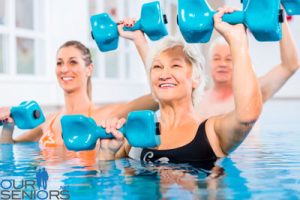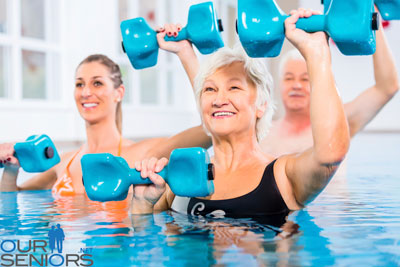 OurSeniors.net is dedicated to making every transition to senior life as safe, secure and satisfying as possible. Some people call this transition “Successful Aging,” and it involves several factors that we can control. Here are a few of the keys to that successful transition to a senior lifestyle:
OurSeniors.net is dedicated to making every transition to senior life as safe, secure and satisfying as possible. Some people call this transition “Successful Aging,” and it involves several factors that we can control. Here are a few of the keys to that successful transition to a senior lifestyle:
- Adequate rest
- Good nutrition
- Good medical care
- Remaining socially involved and physically active
As a person ages, it may actually become more important to get regular exercise than it was at a younger age. Seniors are more likely to develop problems in joints, muscle strength, bone density, maintaining balance and other physical areas, and physical exercise can help to ease or prevent all of these conditions.
On the other hand, many people arrive at retirement or senior living having never done any regular exercise in their lives. This should not be an excuse for making inactivity a part of your senior lifestyle. The evidence shows clearly that physical exercise can reduce the risk of many chronic diseases, can make people feel better, function better, and sleep better. Some of those health benefits start at once, some are more long-term, but it is never too late to start to feel better, is it?
Here are a few of the more important areas in which exercise can improve your senior lifestyle:
Muscle Strength. Popular culture is filled with images of young people who work for hours to have rippling muscles; this image may put seniors off. They may ask, “Who has time for that?” However, experts tell us that a healthy senior lifestyle should include some form of muscle-strengthening activity. As we age, we tend to lose lean muscle mass. Muscle-strengthening activities like lifting weights, working with resistance bands or doing calisthenics will limit this effect of aging. Maintaining muscle strength and mass helps to burn calories, to maintain a healthy weight, strengthens bones, and restores balance.
The human body is responsive to strength training at any age, including the senior living years. It can help reduce symptoms of some common problems like arthritis, osteoporosis, obesity, back pain, and depression. Strength building does not have to mean building large muscles. Lifting weights just two or three times a week can increase strength by building lean muscle. Even a small amount (twice a week) of strength training can increase bone density and overall strength, reducing the risk of falls or fractures
Endurance. Like muscle mass and strength, getting older usually brings a lower level of endurance. It is also true that a senior’s body responds to endurance training just as it does to strength building. Aerobic activities, also called endurance or cardio activities are physical activities in which people move their large muscles for a sustained period of time. That might include riding a bike, a moderate or brisk walk, swimming or even dancing.
Moderate aerobic exercise makes most people feel better almost at once, and regular aerobic activity will make the cardiorespiratory system (your heart and lungs) more fit, increasing your level of endurance. All activities that increase heart rate and breathing are considered endurance exercise.
Balance. Many seniors experience balance issues that can lead to falls and bone fractures. Statistics from the National Institutes of Health tell us that about one-third of people over the age of 65 fall each year. This is a major cause of hospitalization, surgery and disability among seniors. Balance and strength exercises, including activities like yoga and tai chi, can help maintain balance and reduce the risk of falling.
Joints and Flexibility. Flexibility also decreases as we age, as does the chance of developing arthritis in one or more joints. Like strength and endurance, flexibility can be improved with exercise. One of the best therapies for rheumatoid and osteoarthritis is to stay active. Lack of movement contributes to stiffness and weakness in joints.
So Many Others. Regular exercise will help manage weight, strengthen bones and build bone density, slow any decline in memory, improve your mood and relieve depression. There is just no doubt that exercise is one of the keys to a happy, successful senior lifestyle! But where are you going to start?
Before you start any regular exercise program, check with your doctor. If there is no physical reason for not exercising (like heart of lung problems), he or she is going to welcome this idea. After that, here are some OurSeniors.net resources that might help.
YMCA Programs. The Volusia-Flagler “Y” has numerous programs that can help you to stay fit, active and socially connected in your senior lifestyle. These include aerobics, yoga and tai chi, water aerobics and others. You can check them out by phoning one of these numbers:
- 386-532-9622 for the Deltona, Ormond Beach, Port Orange or Edgewater YMCA Branch.
- 386-736-6000 for the Deland YMCA Branch.
- 386-253-5675 for the Holly Hill YMCA Branch.
City of Daytona Leisure Services. Like the “Y” the city offers numerous programs and services that can help seniors get out and be active. Give them a call at 386-210-7690.
Check out the Silver Sneakers Program. Did you know that your Medicare Advantage insurance policy might help to pay for some of these activities like gem membership, yoga or tai chi? You can get information about Advantage Plans available locally by calling Humana Daytona Beach. Their phone number is 386-200-4191.
As always, you can contact an OurSeniors.net Advisor by phone at 866-333-2657 (se habla Español), or by using Contact Us. Check out our website at Ourseniors.net and take an online look at our senior living magazine, OurSeniors.net Magazine. You can view the entire OurSeniors.net Directory of Approved Vendors.
Look for the Seal of Approval. It is your guarantee of vetted, senior-friendly service!

